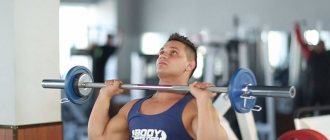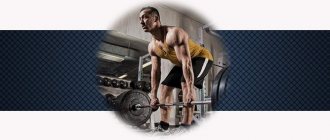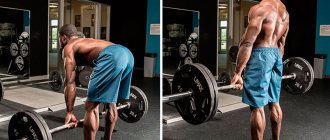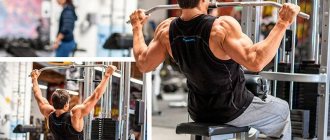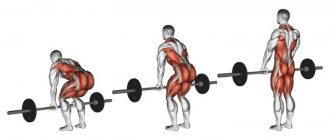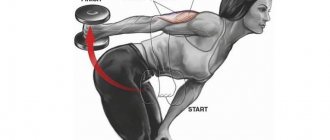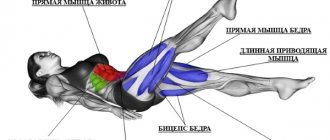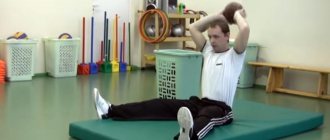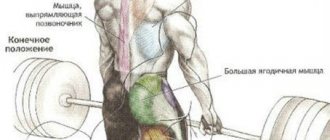Author: Timko Ilya - the ruler of the entire site and fitness trainer | more details >> Rod. 1984 Trained since 1999 Trained since 2007. Author and creator of the site tvoytrener.com. CCM in powerlifting. Champion of Russia and South Russia according to AWPC. Champion of the Krasnodar region according to IPF. 1st category in weightlifting. 2-time winner of the Krasnodar Territory championship in t/a. Author of more than 700 articles on fitness and amateur athletics. Author and co-author of 5 books.
Place in the author rating:
out of competition
(become an author)
Date:
2016-12-07
Views:
27,255
Rating:
5.0
| All articles by the author >> | Medals articles >> |
Articles are loading...
Most coaches and athletes believe that doing squats and deadlifts on the same day is wrong. Here are their arguments:
1.
These are 2 heavy exercises and doing them in one workout is too much work.
2.
If you go all out in a squat, you won't be able to deadlift. And vice versa.
It seems logical. I admit, I used to think so too. But over several years of weightlifting training, I noticed that it was quite common for weightlifters to do squats and deadlifts on the same day. And at the same time they pull and squat a lot and constantly progress in mass and strength. Of course, you can blame it all on steroids, but I suspected that it wasn’t them.
I reasoned like this: the squat and deadlift are, by and large, similar exercises. The muscle groups and working joints are the same. After all, when we pump up the lats or triceps, we often do 2-3 similar exercises for the same muscle group. So why can’t you do 2 similar exercises on your legs, buttocks and back?
What exercises cannot be combined: squats and deadlifts
These exercises are very similar in technique.
They differ in the position of the weight (on the shoulders or on the floor) and, as a rule, in the position of the legs. Both exercises are complex, involving the legs, buttocks, and back. Therefore, the opinion arose that for one workout, two heavy exercises for the same muscle groups are too much. “If you work out with maximum weights in all exercises, then it’s really not recommended to combine squats and deadlifts in one workout,” explains Ksenia Shulga, an expert in the group programs of the federal network of fitness clubs X- Fit .
“In this case, you can perform the first exercise with maximum weight, and in the second use a weight 30% lower than the maximum.”
What's better
Each exercise has its benefits, but how do you decide which is better - squats or deadlifts? The difference between two similar and important exercises is as follows.
Beginners should only perform deadlift exercises with light weights. When the muscles become stronger, you can increase the weight, usually after six months of active training. Squats do not require special preparation.
At the first stages, experiments are not recommended. It is necessary to perform the traditional technique. Squats can be performed in different conditions and variations.
Deadlifts are dangerous for the untrained, especially for thin people with weak muscles. Squats do not require experience and are suitable for everyone; they provide a strengthening effect in different forms.
There is a slight difference between squats and deadlifts. To understand which of them is most suitable, you should understand the ultimate goal of training and ensure the correct distribution of the load. By mastering many techniques, the squat can provide excellent development of the lower back, while the deadlift will strengthen the body almost completely. We must not forget that the exercises are related to each other and the best results will be achieved when they are combined.
What exercises cannot be combined: exercises for triceps and pectoral muscles
Triceps work should not be done before chest exercises. “The triceps is a synergist for the pectoral muscles; it “helps” them perform the exercise,” explains Ksenia Shulga. “At the same time, the triceps are usually weaker, so it is not logical to load it before working on the thoracic region.” However, experienced fitness athletes may have individual goals, and sometimes they want to load the triceps more than the chest. For example, when preparing for the gymnastic elements of CrossFit or for explosive muscle growth. So training the triceps to the chest in general is not prohibited.
Nuances
- One important point is proper breathing. During peak muscle contraction (when we stand up), we exhale; during stretching (when we squat), we inhale.
- It is important to turn off your arms and back and pull the blocks EXCLUSIVELY with your buttocks. Constantly try to relax your upper body and tense your lower body, imagine that your arms are just ropes that connect you to the machine, and all the work should be done by your hips and buttocks.
And girls, dear, remember: if you really want to get pumped up or lose weight, but at the same time you have lower back pain/knees/active varicose veins, etc. - don’t risk your health, you only have it .
Don’t scour the Internet looking for self-medication options, but rather look for a good sports doctor there, because it’s easier for most therapists to ban sports altogether and abdicate responsibility. But you need your health and your good figure, not them? Therefore, the best way out is to look for your own specialist. And risking the ability to fully move for the sake of losing a couple of kilograms is stupid.
What exercises cannot be combined: straight-legged deadlift and hyperextension
If you include such a useful lower back exercise as hyperextension in your training, then it’s really better to avoid straight-legged deadlifts altogether. “Replace it with the Romanian deadlift exercise, which is performed in the set-position position, that is, with slightly bent knees,” advises Ksenia Shulga. “This way you will avoid overstretching your hamstrings.” It is logical to first work the lower back muscles with hyperextension, and then move on to a more global work of the back and buttocks in the form of the Romanian deadlift.
results
At first, it was very difficult for the athletes to get used to such a large load, but after about a month, strength began to increase in both exercises. After about 2 months, the average increase in results in deadlifts and squats was 10% - 15%. And this is a lot for such a period of time.
By the way, for the same person, although one option of deadlift was a priority (classic, on straight legs, or from a stand), the other 2 options were also sometimes included for variety 1-2 times within 2 months.
As I wrote at the beginning of the article, both of these exercises work the same muscles:
- The buttocks work about the same
- The back (back extensors) receives approximately 40% of the load in a squat, and 60% of the load in a deadlift (classic version).
- The front surface of the thigh in a squat receives 60% of the load. And in the deadlift (classic version) - 40% of the load.
That is, the calculation was that in a squat the legs are loaded more, and in the deadlift the back is loaded. And as a result, all major muscle groups receive a heavy load. And this calculation worked.
What exercises should not be combined: squats, lunges, deadlifts and bench presses
All these exercises are complex, maximally using all the muscles of the body. The first three put more strain on the legs, buttocks and back, while the upper shoulder girdle also does not rest, but works to maintain hold.
The bench press primarily works the chest, upper shoulder girdle, and back. But all these exercises are hard, they make you very tired. This is related to the opinion about dividing them into different training days.
“It’s better to combine them only if you have little time to go to the fitness club,” agrees Ksenia Shulga, “and you have to get the most out of each workout. And try not to use maximum weights, try different modes of operation. Usually it is recommended to really differentiate these exercises by performing them on different days of the week.”
What exercises cannot be combined: pull-ups, push-ups, bench presses, standing and sitting
The first exercise maximally utilizes the back, as well as the upper shoulder girdle and arms. Push-ups are an exercise for the chest and triceps, including, depending on the technique, the shoulders. The bench press is primarily an exercise for the chest, standing and seated for the shoulders, but they all also work the back muscles. “They complement each other perfectly, so they can be performed in one workout,” says Ksenia Shulga. “It is recommended to perform the bench press standing first and then sitting, as the former is more difficult to perform.”
Deadlift
The deadlift is considered a difficult and traumatic exercise. Most beginners ask “why should you do deadlifts” and “why are they so useful”? The fact is that this exercise can work almost every muscle in your body. During its implementation, the whole body works and testosterone production increases.
The deadlift is not popular among beginners because of its “heaviness” and abstruse execution technique. No method can replace this exercise, so you will have to learn how to do it correctly if you, of course, want to build a strong and muscular body.
Let's look at the correct technique:
- Place your feet shoulder-width apart.
- Grab the barbell with a grip slightly wider than shoulder-width.
- Arch your lower back and keep your back straight. Look ahead.
- Start moving up. You should place your body weight on your toes and push your chest forward. The bar should be near your feet.
- Once you reach the end point (fully straightening your back with the barbell), lower it, pushing your hips back. Once the bar reaches your knees, bend them until the bar touches the floor.
You must take into account several important rules:
- Warm up thoroughly before lifting heavy weights.
- Follow the execution technique described above. Otherwise, you can get seriously injured and forget about sports forever.
- Use an athletic belt.
What exercises cannot be combined: overhead press and overhead squats
The barbell overhead press is the standing press that has been mentioned more than once. But the latter is more often done with dumbbells, since it is easier in terms of technique. The overhead barbell press puts more axial load on the spine, as it bends the back more strongly.
Overhead squats are squats in which the weight is not placed on the shoulders, but raised above the head. The effect on the spine is very similar to the overhead barbell press. “Only athletes and people who regularly engage in fitness can combine these two exercises in one workout,” says Ksenia Shulga. - If the core stabilizer muscles are not trained properly, they may simply not be able to withstand two such exercises in a row, and the entire load will go to the vertebrae and intervertebral discs. And well-developed muscles will take the pressure of the barbell on themselves, and the exercise will not harm anything.”
In general, as you can see, almost all exercises can be combined. The main thing is to consider the pace of work and the weights with which you train. It cannot be said unequivocally that one or another exercise cannot be combined with another. It all depends on your physical fitness and the purpose of the exercise.
Technique
Crossover squat technique with a lower block:
Feet wider than shoulders, shoulders lowered and relaxed. In a half-squat and WITH A STRAIGHT BACK (you can’t bend forward - you can injure your spine), take the handle (choose any one, it’s not important, but it will be easier with a straight line).
Types of crossover handles
REMEMBER that the exercise begins from the second you approach the apparatus, i.e. We don’t bend our backs under any circumstances!
Pay attention to the grip – classic, straight. We spread our shoulders, connect the shoulder blades, transfer the weight to the heels, as if resting on them, get up and walk away.
We place our feet wider than our shoulders, with our toes pointed to the sides for the correct angle of application of the load, as in a classic squat .
Advice: the abs should be tense IN ALL EXERCISES, this will allow you to “give” part of the load to the abs, and also train yourself to keep your stomach pulled in.
We squat with a straight back with practically motionless knees, (sorry for the directness) “kicking off” our butt and resting on our heels. When lifting, a little . Throughout the entire exercise, you need to tighten your gluteal muscles , thereby creating artificial tension in them for greater effect.
If you don't put your weight on your heels and lean back, you won't get the desired emphasis on the gluteal muscles, but will shift it to the back muscles.
If you not pulled back or carried forward, then you are doing it correctly. If done correctly, you will feel exactly your butt.
We come forward and squat with a straight back. The depth of the squat is maximum, although again, this is a deeply individual thing.
When squatting, we move our legs forward a little and move our glutes back. From this position powerful! by force of the hips and buttocks ! we return to the starting position.
Try different squats: floor, parallel, etc. and check which one gives the maximum impact to the buttocks. For example, in this exercise, I personally feel the buttocks best when squatting just below parallel.
The exercise is NOT FOR BEGINNERS, because... you need already strengthened back muscles. We advise you to gradually add working weight and not rush too much. If you have back problems, take less weight and do 15-20 repetitions. If the lower back muscles are strengthened, then on the contrary, we increase the weight and do up to 8 repetitions.
Perform this exercise as part of a set of exercises for the gluteal muscles once a week with maximum intensity, at the end of your buttock workout.


